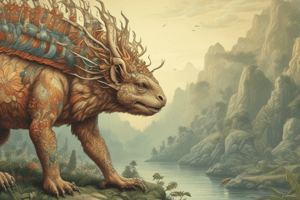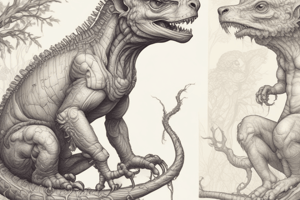Podcast
Questions and Answers
Which mechanisms contribute to microevolution?
Which mechanisms contribute to microevolution?
- Natural selection
- Genetic drift
- Mutation
- All of the above (correct)
What is Darwin's definition of species?
What is Darwin's definition of species?
Groups of organisms that are sufficiently similar in phenotype
What is the key concept of Ernst Mayr regarding species?
What is the key concept of Ernst Mayr regarding species?
Species are a group of interbreeding natural populations that are reproductively isolated from other groups.
Allopatric speciation occurs when reproductive isolation happens without geographic barriers.
Allopatric speciation occurs when reproductive isolation happens without geographic barriers.
Sympatric speciation is easier to achieve compared to allopatric speciation.
Sympatric speciation is easier to achieve compared to allopatric speciation.
Which of the following are examples of prezygotic barriers?
Which of the following are examples of prezygotic barriers?
What is the result of hybridization?
What is the result of hybridization?
Ecological speciation occurs as a result of populations adapting to different ______.
Ecological speciation occurs as a result of populations adapting to different ______.
What is adaptive radiation?
What is adaptive radiation?
What does polyploidy refer to?
What does polyploidy refer to?
Flashcards are hidden until you start studying
Study Notes
Mechanisms of Microevolution
- Natural selection, genetic drift, mutation, and migration are mechanisms that drive microevolutionary change within a population.
- These mechanisms can potentially contribute to macroevolution by leading to the emergence of new species over long periods.
Macroevolutionary Diversity and Species Concepts
- Macroevolutionary diversity refers to the evolution of new species and higher taxonomic groups.
- Several species concepts exist:
- Taxonomic (morphological) concept defines species based on distinct physical and anatomical differences.
- Biological concept defines species based on the ability of individuals to interbreed.
- Darwin regarded species as groups with similar phenotypes.
- Ernst Mayr's concept emphasizes reproductive isolation as a key factor for differentiating species.
- Reproductive Isolation: The inability of individuals from different populations to interbreed successfully, leading to the formation of separate species.
Speciation
- Speciation is the process by which new species arise from existing ones through reproductive isolation and divergence.
- Allopatric speciation: Occurs when a population is geographically separated, leading to the evolution of unique genetic traits and reproductive barriers.
- Sympatric speciation: Occurs when new species arise within the same geographic area, without geographic isolation. This is more challenging due to gene flow, which tends to homogenize the population.
Stages of Reproductive Isolation
- Prezygotic barriers: Prevent mating or fertilization, preventing the formation of a zygote:
- Geographical/Ecological: Separation based on location or resource use.
- Temporal: Reproductive activity occurs at different times between populations.
- Behavioral: Differences in mating behaviors prevent interbreeding.
- Mechanical: Incompatible genitalia prevents mating.
- Cellular: Sperm cannot penetrate the egg.
- Postzygotic barriers: Occur after fertilization, resulting in non-viable or infertile offspring:
- Intrinsic postzygotic barriers: Hybrids exhibit reduced viability, fertility, or abnormal development. This can also occur in subsequent generations.
- Extrinsic postzygotic barriers: Hybrids are poorly adapted to the environment, leading to low fitness.
Local Adaptation and Ecological Speciation
- Local Adaptation: Different populations within a species evolve to suit unique environmental conditions, potentially leading to reproductive isolation. This is accelerated by natural selection, as populations diverge faster in response to different ecological pressures.
- Ecological Speciation: Speciation driven by adaptations to different ecological environments. Natural selection favors traits that enhance survival and reproduction within a specific environment, leading to reproductive barriers.
Adaptive Radiation
- Adaptive radiation occurs when a single ancestor diversifies into many species to fill various ecological roles.
- Closely related species often exhibit distinct phenotypes linked to their environment (e.g., beak shapes adapted to specific food sources).
- Ecological opportunity: Factors that promote adaptive radiation:
- Colonization of new areas with few competitors.
- Extinctions of other species, reducing competition.
- Evolution of novel traits that allow access to new resources.
- High propensity for speciation: Some groups have a greater tendency to undergo speciation than others.
Hybridization
- Hybridization occurs when two reproductively isolated species interbreed.
- Hybrids can be:
- Sterile: Unable to reproduce.
- Fertile: Capable of reproduction, potentially leading to gene flow and merging of species.
- Polyploidy: A form of speciation where an organism has more than two complete sets of chromosomes. This is an example of sympatric speciation.
- Allopolyploidy: Occurs when two different species hybridize and the offspring possesses a diploid set of chromosomes from both parent species.
Studying That Suits You
Use AI to generate personalized quizzes and flashcards to suit your learning preferences.




